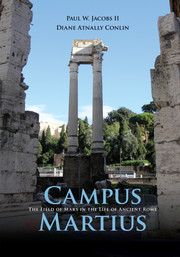Book contents
- Frontmatter
- Contents
- Illustrations
- Acknowledgments
- Maps
- Introduction: “This Place Was Holiest of All”
- Chapter One “The Size of the Plain Is Remarkable”: Defining the Limits of the Campus Martius in Time and Space
- Chapter Two Gathering Troops in the War God's Field
- Chapter Three “Very Costly Temples”: The Campus Martius and Republican Temple Construction
- Chapter Four “Chariot Races,” “Three Theatres,” “An Amphitheatre,” and More: Entertainment in the Campus Martius
- Chapter Five “Colonnades about It in Very Great Numbers”: The Porticoes of the Campus Martius
- Chapter Six Between the Aqua Virgo and the Tiber: Water and the Field of Mars
- Chapter Seven “A Zeal for Buildings”: Reshaping of the Space by the Emperors
- Conclusion: “The Rest of the City a Mere Accessory”
- Appendix A Chronology of Development in the Campus Martius to the Early Fourth Century c.e.
- Appendix B Glossary of Architectural Terms
- Notes
- Selected Bibliography
- Index
- Plate Section
Chapter Five - “Colonnades about It in Very Great Numbers”: The Porticoes of the Campus Martius
Published online by Cambridge University Press: 18 December 2014
- Frontmatter
- Contents
- Illustrations
- Acknowledgments
- Maps
- Introduction: “This Place Was Holiest of All”
- Chapter One “The Size of the Plain Is Remarkable”: Defining the Limits of the Campus Martius in Time and Space
- Chapter Two Gathering Troops in the War God's Field
- Chapter Three “Very Costly Temples”: The Campus Martius and Republican Temple Construction
- Chapter Four “Chariot Races,” “Three Theatres,” “An Amphitheatre,” and More: Entertainment in the Campus Martius
- Chapter Five “Colonnades about It in Very Great Numbers”: The Porticoes of the Campus Martius
- Chapter Six Between the Aqua Virgo and the Tiber: Water and the Field of Mars
- Chapter Seven “A Zeal for Buildings”: Reshaping of the Space by the Emperors
- Conclusion: “The Rest of the City a Mere Accessory”
- Appendix A Chronology of Development in the Campus Martius to the Early Fourth Century c.e.
- Appendix B Glossary of Architectural Terms
- Notes
- Selected Bibliography
- Index
- Plate Section
Summary
With the onset of winter in 169 b.c.e., Perseus, the King of Macedonia, was wary that the forces of Rome would attack his poorly defended kingdom. Earlier that year, envoys from Rome had traveled through the Peloponnese and Aetolia south of Macedonia, shoring up the support of allied cities. Now, Perseus expected the worst. Knowing that the Illyrians along the modern Dalmatian coast to his west had been wavering in their support for Macedonia and could provide Rome with a pathway to his kingdom, Perseus decided to take the offensive. Waiting until the winter solstice when the snows protected him from invasion across the western passes from Thessaly, Perseus invaded Illyricum, capturing a Roman garrison. With one success under his belt, Perseus continued to attack and overran eleven other Roman forts. A powerful Roman response was now assured.
With war against the Macedonians clearly on their minds, the Romans chose their two consuls and six praetors for the upcoming year. Lucius Aemilius Paullus was elected consul and directed to lead the forces against Macedonia. Gnaeus Octavius was chosen as a praetor and tasked with conducting Rome's naval operations. In April 168 b.c.e., shortly after the Latin Festival concluded, the fleet departed east. Octavius's warships traveled up the east coast of Greece to Heracleum, Meliboea, and the island of Samothrace. At these locations, Octavius would have seen extraordinary Hellenistic architecture, particularly at Samothrace with its remarkable sanctuary complex composed of altars, a circular theatrical area, banquet rooms, a monumental gate, and a colonnade. Approximately 104 meters long, the Samothrace colonnade was one of the largest in Greece. Two aisles were created by two rows of columns, one down the center of the enclosed space and the other along its eastern edge. The western length and the ends were enclosed. The colonnade sat next to a fountain crowned by the famous Nike of Samothrace, now in the Louvre. Situated on a hill, the marbled colonnade would have afforded Octavius with a panoramic view across the entire complex.
- Type
- Chapter
- Information
- Campus MartiusThe Field of Mars in the Life of Ancient Rome, pp. 95 - 111Publisher: Cambridge University PressPrint publication year: 2015



